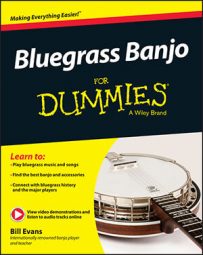Thousands of new players became attracted to the sound of the bluegrass banjo after hearing Earl Scruggs play, first with mandolin player Bill Monroe in the 1940s and then with longtime musical partner Lester Flatt from 1949 to 1968. As new musicians absorbed Earl’s style, they contributed innovations of their own, which have greatly expanded the range of music that can be played on the banjo using bluegrass picking techniques.
Today, you hear the sound of bluegrass banjo not only from mainstream bands like Alison Krauss & Union Station (featuring the rock‐solid banjo playing of Ron Block) and the Lonesome River Band (with Sammy Shelor), but also in jam bands like Leftover Salmon (with Andy Thorn) and the Infamous Stringdusters (with Chris Pandolfi) and in the acoustic/chamber/jazz fusion music of the Punch Brothers (featuring the amazing Noam Pikelny).
It’s all about Earl
It’s impossible to overestimate Earl Scruggs’s contributions to the art of bluegrass banjo playing. Hundreds of thousands of players from all over the world took up the banjo in the 1950s and 1960s and became bluegrass musicians after hearing Scruggs play “Foggy Mountain Breakdown” and “The Ballad of Jed Clampett.”
Utilizing a blazingly precise technique that allowed him to play faster than anyone thought possible on the banjo, Earl singlehandedly created an entire musical language that has been used by generations of players to create songs and accompany others in all kinds of musical contexts.
The genius of Earl’s accomplishments is in how flexible his three‐finger approach is in regard to creating different kinds of sounds on the banjo. Influential bluegrass players such as Sonny Osborne, J. D. Crowe, Bill Emerson and Jim Mills have emphasized different aspects of Earl’s technique to create their own unique banjo styles that remain solidly connected to Earl’s approach.
Melodic and single‐string styles
If there is one limitation to Scruggs‐style banjo, it’s the challenge of playing fast‐moving melodies that move up and down a scale, as you hear in fiddle tunes, modern jazz, and classical music. Beginning in the 1950s, banjo players introduced new picking approaches to solve this technical problem.
Melodic banjo style
Melodic banjo enables you to play scales on the five‐string banjo where you strike a different string with each consecutive note you play, as in Scruggs‐style banjo. Bill Keith and Bobby Thompson came up with this idea independently of one another in the early 1960s.
As members of Bill Monroe’s band (the same band that Earl Scruggs played in back in the 1940s), bluegrass banjo players were dazzled by Keith’s ability to play fiddle tunes like “Sailor’s Hornpipe” and “Blackberry Blossom,” capturing every note that the fiddle played.
Single‐string banjo style
Single‐string banjo was first developed in the 1950s by bluegrass pioneers Eddie Adcock and Don Reno. Borrowing from lead guitar‐playing techniques, single‐string style allows you to play consecutive notes of a scale on the same string, using the thumb and fingers of the picking hand in alternation in a manner that’s similar to how guitar and mandolin players use a flatpick.
The musical potential of this way of playing banjo took a huge leap forward in the 1980s with Béla Fleck’s technical breakthroughs. As new innovators such as Noam Pikelny and Ryan Cavanaugh continue to open up the potential of this way of playing, the banjo is finding a more comfortable home in classical and jazz music.

